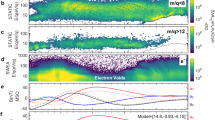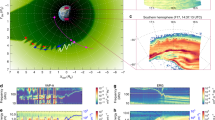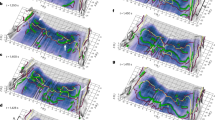Abstract
Understanding and predicting processes that perturb planetary ionospheres is of paramount importance for long-distance radio communication. Perhaps the oldest known ionospheric disturbances are ‘sporadic E layers’1: unpredictable and short-lived concentrations of plasma2, which can bounce radio signals over the horizon for thousands of kilometres3. Consequentially, local radio broadcasts can become jammed by more distant transmissions, and thus sporadic E layers are a potentially serious complication for commercial radio, aviation, shipping or the military. According to the current theory of their formation, we should also expect an equal proportion of localized ionospheric density depletions to develop. However, no such ‘sporadic E rifts’ have been detected in over 85 years of ionospheric research. In addition, despite being common at Earth, no sporadic E layers have yet been reported at other planets. Here we report the detection of sporadic E-like phenomena in the ionosphere of Mars by NASA’s Mars Atmosphere and Volatile Evolution (MAVEN) spacecraft, providing a physical explanation for previous unexplained observations at Mars4,5,6,7. We observe enhanced-density layers that can be explained through the presence of a sporadic E-like mechanism, and we establish the existence of sporadic E rifts in nature. We find that, unlike the case at Earth, Martian sporadic E features are trapped in a near-perpetual state of dynamic formation and may form at predictable locations. Also unlike the case at Earth, Martian sporadic E features are readily accessible to satellites, and indeed MAVEN has already encountered more of the phenomena at Mars than have ever been explored in situ at Earth with suborbital rockets.
This is a preview of subscription content, access via your institution
Access options
Access Nature and 54 other Nature Portfolio journals
Get Nature+, our best-value online-access subscription
$29.99 / 30 days
cancel any time
Subscribe to this journal
Receive 12 digital issues and online access to articles
$119.00 per year
only $9.92 per issue
Buy this article
- Purchase on Springer Link
- Instant access to full article PDF
Prices may be subject to local taxes which are calculated during checkout




Similar content being viewed by others
Data availability
MAVEN data are available from the Planetary Plasma Interactions Node of the NASA Planetary Data System (https://pds-ppi.igpp.ucla.edu/).
Code availability
Software to analyse data from the MAVEN Particles and Fields package is available through the MAVEN Science Data Center (https://lasp.colorado.edu/maven/sdc/public/), and through the University of California at Berkeley’s Space Science Laboratory TPLOT package (http://sprg.ssl.berkeley.edu/data/maven/misc/socware/).
References
Appleton, E. V. On two methods of ionospheric investigation. Proc. Phys. Soc. 45, 673–688 (1933).
Pfaff, R. F. The near-Earth plasma environment. Space Sci. Rev. 168, 23–112 (2012).
Dellinger, J. H. The role of the ionosphere in radio wave propagation. Trans. Am. Inst. Electr. Eng. 58, 803–822 (1939).
Withers, P., Mendillo, M., Risbeth, H., Hinson, D. P. & Arkani-Hamed, J. Ionospheric characteristics above Martian crustal magnetic anomalies. Geophys. Res. Lett. 32, L16204 (2005).
Bougher, S. et al. Early MAVEN Deep Dip campaign reveals thermosphere and ionosphere variability. Science 350, aad0459 (2015).
Grebowsky, J. M. et al. Unique, non-Earthlike, meteoritic ion behavior in upper atmosphere of Mars. Geophys. Res. Lett. 44, 3066–3072 (2017).
Mayyasi, M., Withers, P. & Fallows, K. A sporadic topside layer in the ionosphere of Mars from analysis of MGS radio occultation data. J. Geophys. Res. Space Phys. 123, 883–900 (2017).
Whitehead, J. D. The formation of the sporadic E layer in the temperate zones. J. Atmos. Terr. Phys. 20, 49–58 (1961).
Hines, C. O. The formation of midlatitude sporadic E layers. J. Geophys. Res. 69, 1018–1019 (1964).
Whitehead, J. D. Production and prediction of sporadic E. Rev. Geophys. 8, 65–144 (1970).
McFadden, J. P. et al. MAVEN SupraThermal and Thermal Ion Composition (STATIC) instrument. Space Sci. Rev. 195, 199–256 (2015).
Mahaffy, P. R. et al. The Neutral Gas and Ion Mass Spectrometer on the Mars Atmosphere and Volatile Evolution Mission. Space Sci. Rev. 195, 49–73 (2015).
Andersson, L. et al. The Langmuir Probe and Waves (LPW) Instrument for MAVEN. Space Sci. Rev. 195, 173–198 (2015).
Seddon, C. J. in AGARDograph 34: Sporadic E Ionization (ed. Landmark, B.) 171–182 (NATO Advisory Group for Aeronautical Research and Development, 1958).
Grebowsky, J. M. & Aikin, A. C. in Meteors in the Earth’s Atmosphere (Einaudi, F.) 189–214 (Cambridge University Press, 2002).
Earle, G. D., Kane, T. J., Pfaff, R. F. & Bounds, S. R. Ion layer separation and equilibrium zonal winds in midlatitude sporadic E. Geophys. Res. Lett. 27, 461–464 (2000).
Connerney, J. E. P. et al. Magnetic lineations in the ancient crust of Mars. Science 284, 794–798 (1999).
Mitchell, D. L. et al. The MAVEN Solar Wind Electron Analyzer. Space Sci. Rev. 200, 495–528 (2016).
Pätzold, M. et al. A sporadic third layer in the ionosphere of Mars. Science 310, 837–839 (2005).
Crismani, M. M. J. et al. Localized ionization hypothesis for transient ionospheric layers. J. Geophys. Res. Space Phys. 124, 4870–4880 (2019).
Shinagawa, H. & Cravens, T. E. The ionospheric effects of a weak intrinsic magnetic field at Mars. J. Geophys. Res. 97, 1027–1035 (1992).
Riousset, J. A. et al. Electrodynamics of the Martian dynamo region near magnetic cusps and loops. Geophys. Res. Lett. 41, 1119–1125 (2014).
Glatzmaier, G. A. & Roberts, P. H. A three-dimensional self-consistent computer simulation of a geomagnetic field reversal. Nature 377, 203–209 (1995).
Roddy, P. A., Earle, G. D., Swenson, C. M., Carlson, C. G. & Bullett, T. W. Relative concentrations of molecular and metallic ions in midlatitude intermediate and sporadic E layers. Geophys. Res. Lett. 31, L19807 (2004).
Haldoupis, C., Pancheva, D., Singer, W., Meek, C. & MacDougall, J. An explanation for the seasonal dependence of midlatitude sporadic E layers. J. Geophys. Res. 112, A06315 (2007).
Didebulidze, G. G. & Lomidze, L. N. The formation of sporadic E layers by a vortical perturbation excited in a horizontal wind shear flow. Ann. Geophys. 26, 1741–1749 (2008).
Smith, L. G. & Mechtly, E. A. Rocket observations of sporadic E layers. Radio Sci. 7, 367–376 (1972).
Collinson, G. et al. Traveling ionospheric disturbances at Mars. Geophys. Res. Lett. 46, 4554–4563 (2019).
Connerney, J. E. P. et al. The MAVEN magnetic field investigation. Space Sci. Rev. 195, 257–291 (2015).
Schunk, R. and Nagy, A. F. Ionospheres: Physics, Plasma Physics, and Chemistry Cambridge Atmospheric and Space Science Series, 2nd edn (Cambridge University Press, 2009).
Acknowledgements
This work was supported by the MAVEN mission. We thank C. Fowler for assistance in differentiating Martian sporadic E features from Martian ionospheric irregularities. We also thank A.P. McCall of the Kunyung Institute for Space Physics, Melbourne, Australia, for useful discussions.
Author information
Authors and Affiliations
Contributions
G.A.C. analysed the data and wrote the paper. J.G. contributed the explanation for the fundamental physical mechanism at play. J.M., D.M., M.B., J.E. and B.J. conceived and designed the experiment. P.W. and M.F.V. compared our in situ results with remote previous sensing observations. R.L. analysed the data.
Corresponding author
Ethics declarations
Competing interests
The authors declare no competing interests.
Additional information
Peer review information Nature Astronomy thanks Michael Pezzopane, Hiroyuki Shinagawa and the other, anonymous, reviewer(s) for their contribution to the peer review of this work.
Publisher’s note Springer Nature remains neutral with regard to jurisdictional claims in published maps and institutional affiliations.
Extended data
Extended Data Fig. 1 Comparison of plasma density vs. altitude of Sporadic E at Mars and Earth.
Comparison of observations of Sporadic-E-like features at Mars (red) and Earth (green). Each panel shows plasma density (cm-3) versus altitude (km). Top panels show observations of ion density (each species colour coded), Bottom panels show electron densities. Panels a,b.) MAVEN in situ observations (Fig. 2, main paper); Panels c,d.) remote-sensing observations by the Mars Global Surveyor (MGS); Panels e,f.) In situ observations of Sporadic E at Earth by suborbital rocketcraft. Consistent with previous remote-sensing results from Mars and at Earth, Martian Sporadic E appear to be narrow structures only a few kilometres across.
Extended Data Fig. 2 Expanded MAVEN data plots.
Expanded plot of additional supporting MAVEN data from our two prime events.
Supplementary information
Supplementary Information
Supplementary discussion, Tables 1 and 2 and Fig. 1.
Rights and permissions
About this article
Cite this article
Collinson, G.A., McFadden, J., Grebowsky, J. et al. Constantly forming sporadic E-like layers and rifts in the Martian ionosphere and their implications for Earth. Nat Astron 4, 486–491 (2020). https://doi.org/10.1038/s41550-019-0984-8
Received:
Accepted:
Published:
Issue Date:
DOI: https://doi.org/10.1038/s41550-019-0984-8
This article is cited by
-
Using GNSS radio occultation data to derive critical frequencies of the ionospheric sporadic E layer in real time
GPS Solutions (2021)
-
The MAVEN Radio Occultation Science Experiment (ROSE)
Space Science Reviews (2020)



